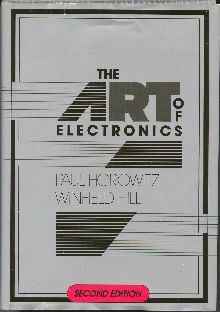
The Art of Electronics
P. Horowitz and W. Hill
Cambridge University Press, 1989, 1123 pages
Student Manual for The Art of Electronics
T. C. Hayes and P. Horowitz
Cambridge University Press, 1989, 614 pages

The Art of ElectronicsP. Horowitz and W. HillCambridge University Press, 1989, 1123 pages
Student Manual for The Art of Electronics
|
 t's hard to resist over-praising The Art of Electronics,
which is one of the most widely-used textbooks on electronic circuit design
for non-engineers. The intended audience is people outside of engineering,
like grad students and experimenters, who need to build electronic equipment
for a specific task.
t's hard to resist over-praising The Art of Electronics,
which is one of the most widely-used textbooks on electronic circuit design
for non-engineers. The intended audience is people outside of engineering,
like grad students and experimenters, who need to build electronic equipment
for a specific task.
It goes without saying that reading this book will not convert you into an electronic engineer. There is almost no mathematics, and specialized disciplines like microwave circuits are not covered. But it is also most definitely not a cookbook; many of the circuits are only useful as teaching devices, and would never be used in the real world. Their purpose is to teach, and the authors excel at making designing circuits seem easy. Even at 1123 pages, this book won't teach you everything; but with a little effort, this book will provide a good basic understanding of how to design and build analog circuits using discrete components and integrated circuits. The second half of the book covers digital electronics; the coverage here is mostly out of date. I suspect that over the years, many EE students--many of whom go their entire four years without picking up a soldering iron--have put on a Groucho Marx mask and purchased a copy of this book at the school bookstore, and read it under the covers in bed with a flashlight when no one was looking.
The main problem with this book is that a third edition is definitely overdue. Many of the components listed in the book, such as zinc-carbon batteries and many of the op amps, are no longer available. Advances in computer technology have made some of the information on digital electronics obsolete.
The book is generally well-written and uses an informal, vernacular language, a style that has also been effectively used by other authors such as P.C.D. Hobbs in Building Electro-Optical Systems: Making it All Work. The emphasis is on calculating the voltage and current at each point in the circuit in order to keep the magical gray smoke from leaking out. There are some exercises in each chapter, but the answers are not provided. The "bad circuits" section at the end of each chapter may have been fun for the authors, but to many readers, it is just baffling, because the reasons why the circuits are bad are not explained. The Student Manual corrects most of these flaws, and is essential if you intend to work through the book to seriously learn how to build things.
